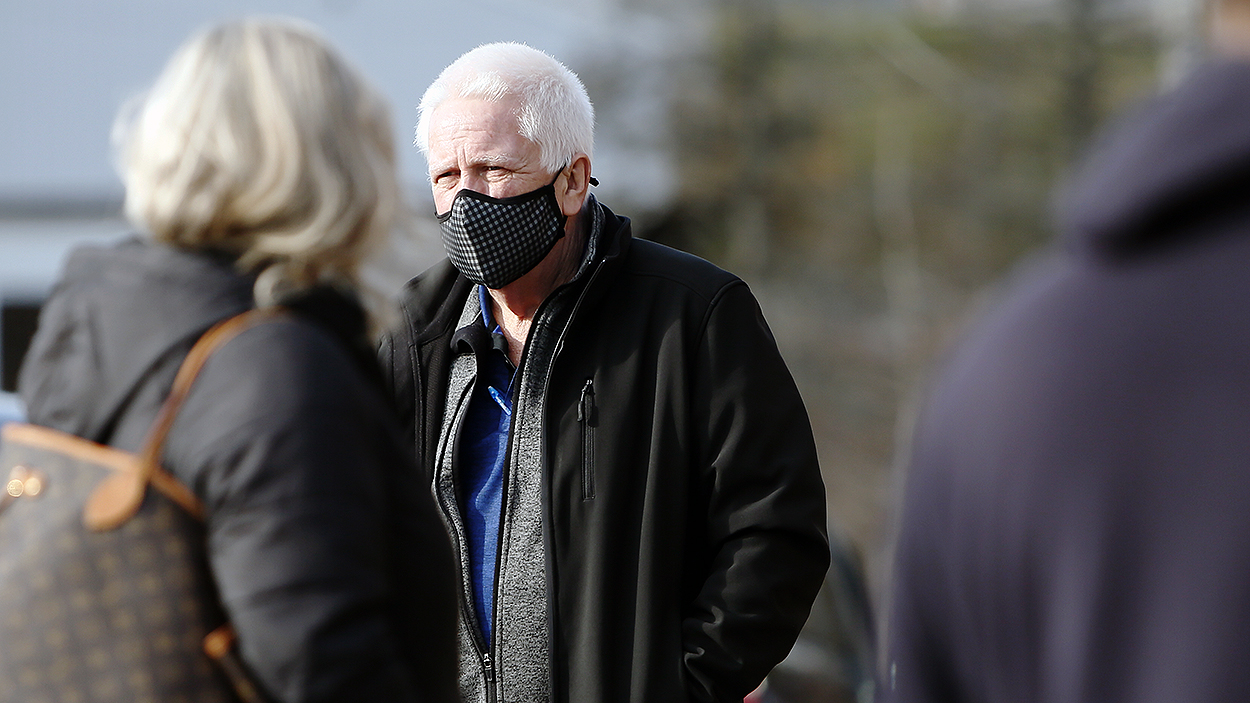timeline
2020: COVID-19 in Nova Scotia
Lockdowns, closures and death as a global pandemic takes hold

caption
People line up outside a post office in Lakeside on Dec. 11, 2020.It’s been a year of COVID-19; a year fraught with uncertainty.
In December 2019, a mysterious pneumonia began afflicting people in Wuhan City, China. The illness was later found to be caused by a virus in the coronavirus family, officially named SARS-CoV-2, or as it became widely referred to: COVID-19.
By mid-January, the first recorded case outside of China was diagnosed in Thailand. By the end of the month, 18 countries had confirmed cases and the World Health Organization declared the virus a Public Health Emergency of International Concern. On March 11, the WHO declared a pandemic.
It didn’t take long for the virus to appear in Canada. On Jan. 25, Canada saw its first presumptive COVID-19 case: a Toronto man returning from Wuhan, China.
As the virus reached Canada, Nova Scotia government officials began preparing for when COVID-19 would inevitably reach the province.
The following timeline shows key dates in Nova Scotia’s fight against the coronavirus.
February
Feb. 28: Nova Scotia says anyone travelling from an affected area should monitor their health for 14 days after arriving in the province.
March
March 4: Nova Scotia’s Regional Centres for Education cancel any school trips abroad until April 30, 2020.
March 9: Nova Scotia restricts visitors who’ve travelled internationally in the past 14 days from entering long-term care homes.
March 13: The province closes all museum sites and the Art Gallery of Nova Scotia. Health-care workers, teachers, civil servants and other public sector employees of Nova Scotia are instructed to self-isolate if returning from international travel. This also applies to students of public schools and children in regulated child-care centres who may have travelled with family.
March 14: Volunteer organizations can no longer visit correctional facilities in Nova Scotia. Family and friends can only have non-contact visits with inmates. They have to talk through telephones, separated by glass.
March 15: Nova Scotia announces its first three presumptive COVID-19 cases. The cases were unrelated to one another; all three were related to travel abroad. Several restrictions are put in place, effective immediately:
- Long-term care facilities stop allowing visitors.
- Businesses and organizations, such as restaurants, bars, movie theatres and other gathering spots, are told to practice physical distancing of two metres and keep gatherings below 150 people.
- The Shubenacadie Wildlife Park closes until further notice.
- Nova Scotia correctional facilities close to visitors.
- Anyone who’s travelled outside of the country must self-isolate, even those without symptoms.
- Public schools must remain closed after March break.
March 16: Public health inspectors are on site at Halifax Stanfield International Airport and J.A. Douglas McCurdy Sydney Airport. More restrictions are implemented:
- Casinos must close.
- Bars are no longer allowed to operate VLT machines.
- Halifax universities close for a week as professors prepare to move education online.
March 17: Regulated child-care centres are closed until April 3, to be reassessed at the end of this period. Public gatherings are limited to no more than 50 people.
March 18: The province announces more measures to slow the spread of the virus, effective immediately:
- Doctors and pharmacists begin offering virtual care via telephone or video calls. Pharmacists can renew most prescriptions and the government will cover the assessment fee.
- Employers can no longer require a doctor’s note for employees who need to be off work.
- The College of Physicians and Surgeons Nova Scotia waives the fee for retired doctors wanting to renew their licence and return to work.
- More nurses brought in to assist with 811 staffing, including some retired nurses.
- Access Nova Scotia and Registry of Motor Vehicle offices close.
- Driver’s licence and vehicle registrations expiring in March, April or May are extended until Aug. 31.
- 41 people are released from correctional facilities in Nova Scotia’s four adult facilities on temporary absence, allowed to serve their sentences on weekends.
March 19: The following measures take effect:
- No tenant can be evicted for the next three months because their income has been hit by COVID-19.
- Restaurants and bars are only allowed to offer take-out food. In-person dining is prohibited. All drinking establishments, wineries and distillery tasting rooms and craft tap rooms are ordered closed but are allowed to continue selling their product through their stores.
- Gyms, hair and nail salons, barbers, spas and body art establishments are required to close.
- Anyone travelling into Nova Scotia from abroad must self-isolate 14 days upon arrival.
Several other measures, including:
- Emergency funding of $230,000 for Senior Safety Programs and Community Links to help vulnerable older adults.
- The province says Nova Scotian university students still living in residence need to move out if possible. This is to make physical distancing easier for students who have nowhere else to go or cannot travel due to restrictions.
March 20: The province begins distributing $2.2 million to help individuals and family members on income assistance get an extra $50 to cover food, cleaning supplies and personal care items. The provincial government makes $161 million available to help small and medium sized businesses in Nova Scotia. All government loan payments and small business fees are suspended until June 30.
March 22: Nova Scotia’s first state of emergency is declared to help contain the spread of the virus. This gives the government the power to do whatever is deemed necessary for the protection of Nova Scotians. Under the state of emergency:
- Nova Scotians are instructed not to leave the province and to only leave home for essential reasons like grocery shopping.
- Gatherings are limited to 5 people under the Health Protection Act, with only essential services exempt from this rule.
- Beaches, provincial parks and tourist attractions are all closed.
- Nova Scotia’s borders are tightened. All travellers entering the province are questioned and told to self-isolate for two weeks.
- Police are authorized to charge businesses and individuals found in violation of public health rules around physical distancing and self-isolation.
March 23: Public schools remain closed following March break. Universities begin online classes.
March 26: A fire ban is introduced for wooded areas in any part of the province. This is meant to reduce the chances of wildfires, which could further strain public services. Reservations for the 2020 camping season are put on hold until further notice.
March 27: Measures are announced by the Nova Scotia government:
- Retail and commercial landlords are encouraged to defer lease payments for the next three months to businesses ordered closed under public health orders. Landlords who register to do this by April 3 can claim up to $5,000 a month in losses.
- The Department of Community Services announces a program to provide 100 phones and calling plans to its most vulnerable clients, especially those who are self-isolating alone. It also announces $200,000 to support transition houses that serve women and children and $55,000 to support 12 community food banks.
March 30: Restaurants are allowed to include alcohol with delivery and takeout orders, so long as the cost of the alcohol is no more than three times the price of the food ordered. All public schools and licensed child-care providers are ordered to remain closed until at least May 1.
April
April 5: More options for testing are put in place to help identify community spread of COVID-19. These include temporary primary assessment centres in communities with more known cases, a Nova Scotia Health Authority mobile assessment centre, two Emergency Health Services assessment units and 24-hour operations at the QEII Health Services Centre’s microbiology lab.
April 6: Nova Scotia records its first COVID-19 related death. The woman, who was in her 70s with underlying medical conditions, dies in hospital in the eastern zone. Long-term care homes given instructions for cleaning, monitoring of residents and staff, testing and reporting.
April 14: Front-line workers in all public and private long-term care homes, residential care facilities and home-care agencies are required to wear masks to prevent the spread of the virus.
April 17: First three deaths announced at Northwood long-term care home in Halifax, in the central zone.
April 19: Implementation of an emergency plan to respond to the COVID-19 outbreak at Northwood, including establishing a recovery unit and onsite treatment and testing.
April 22: 55 new cases of COVID-19 identified. This is the highest number of new cases in a single day to date.
May
May 1: Provincial and municipal parks, trails, community gardens, garden centres and plant nurseries reopen. Public health restrictions ease on other activities, including sport fishing and boating. Golf driving ranges reopen.
May 15: Introduction of the family bubble, where two family households can come together without physical distancing. The families must be mutually exclusive and consider, age, occupation and health condition of all household members when choosing a family to connect with.
May 22: List of possible COVID-19 symptoms expanded. The new list includes: fever, cough or worsening of a previous cough, sore throat, headache, shortness of breath, muscle aches, sneezing, nasal congestion or runny nose, hoarse voice, diarrhea, unusual fatigue, loss of sense of smell or taste and red, purple or blue lesions on the feet, toes or fingers without clear cause.
May 29: Nova Scotia sets gathering limit of 10 requiring physical distancing, excluding members of the same household or family household bubble. Limit of 15 for outdoor weddings and funerals.
June
June 5: Most businesses required to close under public health order reopen. This includes restaurants, bars, hair and nail salons, spas, tattoo and piercing shops, gyms, yoga studios and veterinary clinics. Health providers in dentistry, optometry, chiropractic, physiotherapy, massage therapy, podiatry and naturopathy also reopen.
June 15: Visits resume at long-term care homes and homes for people with disabilities. Visits must take place outdoors and visitors are required to physically distance from residents and staff. Other measures include a maximum of two visitors at a time, COVID-19 screenings for visitors upon entry, a log of visitor information and staff monitoring of visits.
June 18: Family household bubble replaced by gatherings of 10 people without physical distancing. Large gatherings for social events, faith gatherings, sports and physical activity, weddings, funerals and arts and culture events expanded to 50 people.
June 26: Restaurants and bars are allowed to operate at 100 per cent capacity and can serve customers until midnight with appropriate distancing between tables.
July
July 3: Atlantic bubble is created. Travel is allowed in the Atlantic Canadian provinces – Nova Scotia, New Brunswick, Prince Edward Island and Newfoundland and Labrador – without requirement of 14-day self-isolation. Gathering limits increase for outdoor and indoor events planned by recognized businesses and organizations. With physical distancing rules in place, an outdoor event can host up to 250 people and an indoor event 50 per cent capacity to a maximum of 200.
July 7: Travellers entering Nova Scotia from outside the Atlantic bubble are required to fill out a tracking and self-declaration form. Non-bubble visitors to provide an address and phone number to ensure they are meeting self-isolation requirement.
July 22: New changes to Nova Scotia’s long-term care home directive. This includes limited indoor and outdoor visits, resident and staff gatherings of 10 without physical distancing, sightseeing bus trips for groups of 10 including residents, staff and driver, and reopening of hair salons in long-term care homes to residents.
July 24: Masks required for drivers and passengers on all public transportation. This includes municipal transit buses and ferries, school buses, community transit vehicles and private taxis and shuttles.
July 31: Masks required for most indoor public spaces. This includes retail businesses, shopping centres, hair and nail salons, spas, tattoo and piercing shops, restaurants and bars (except while eating or drinking), places of worship or faith gatherings, places for cultural or entertainment services or activities, places for sports and recreational activities, places for events such as conferences and receptions, municipal or provincial government locations offering services to the public, common areas of tourist accommodations and office buildings (except private offices), public areas of university or college campuses (except for classrooms, labs, offices and residences), train or bus stations, ferry terminals and airports.
August
Aug. 20: Post-secondary students entering Nova Scotia from outside the Atlantic bubble required to get tested for COVID-19 and self-isolate for 14 days. Students cannot attend in-person classes until the isolation period is completed and they receive negative test results.
Aug. 26: Gathering limit for before- and after-school programs is set at 15 without physical distancing.
Aug. 28: Long-term care residents permitted to leave for medical appointments accompanied by family members. Cap on the number of people residents can identify to visit indoors is lifted.
September
Sept. 8: Public schools reopen for the start of the school year. Masks are mandatory in grades 4 to 12. Schools must be ready to investigate COVID-19 exposures and test close contacts, and notify families of students and staff on exposures.
Sept. 11: Long-term care homes allow designated caregivers to help care for and support residents. A designated caregiver can be a family member, spouse, friend or other support person as long as they had an established caregiving relationship with the resident prior to COVID-19. Ease of some self-isolation requirements for out-of-province rotational workers. Workers who move within Canada can now interact with their household without physical distancing, spend time outside on their own property, go for a drive or walk and visit outdoor public spaces.
Sept. 28: Long-term care residents permitted to have pre-arranged off-site day visits with family in their homes within the Atlantic bubble.
October
The beginning of October marks the start of the second wave of COVID-19, says Dr. Robert Strang, the province’s chief medical officer of health. On Oct. 1, there are only two active cases in Nova Scotia.
Oct. 5: Nova Scotians are advised to have smaller Thanksgiving celebrations while maintaining other health precautions.
Oct. 15: The Canada COVID-19 Exposure Alert app becomes available for use in Nova Scotia. It notifies users when they have been in proximity to someone who has tested positive for COVID-19 for extended periods of time.
Oct. 22: Nova Scotians are advised against travelling to the Campbellton-Restigouche area of New Brunswick as cases there spike.
Oct. 31: The province announces five new cases, the largest single day increase since May.
November
Nov. 9: Stricter rules are put in place for those isolating after arriving from outside the Atlantic bubble. Travellers can no longer isolate in a location with other people, and if there are other people at that location they must isolate for 14 days as well.
Nov. 16: The first two school based cases are identified in the province, at Graham Creighton Junior High in Cherry Brook and Auburn Drive High in Cole Harbour.
Nov. 20: New restrictions are put in place limiting the movement of long-term care residents and requiring bars and restaurants to collect contact information of patrons to aid in contact tracing.
Nov. 21: The first pop-up rapid testing site opens at the Dome nightclub in Halifax, conducting 150 tests and identifying one infection. The pop-up sites are intended to be used by the 18-35 age group who had been seeing an increase in case numbers.
Nov. 23: The Atlantic bubble effectively ends as Newfoundland and Labrador and Prince Edward Island require self-isolation from travellers entering from the other Atlantic provinces for at least two weeks. Nova Scotia announces 11 new cases.
Nov. 24: The province announces 37 new cases, making it the highest single day increase of the second wave. There are 87 active cases.
Nov. 26: New restrictions take effect for HRM and Hants County until Dec. 9. The government requests anyone who went to a bar after 10 p.m. in the last two weeks to book a COVID test even if they are asymptomatic, as well as:
- Gathering limits reduced to five.
- Mandatory masking in the common areas of multi-unit buildings.
- Restaurants and bars closed to in-person dining.
- Retail must operate at 25 per cent capacity.
- Stronger enforcement of illegal gatherings, with fines of up to $1,000.
- Province-wide restriction on visitors to long-term care facilities.
December
Dec. 4: The new restrictions for HRM and Hants County are extended until at least Dec 16. Asymptomatic testing capability is increased across the province both at drop-in locations and pop-up sites in Halifax and Dartmouth.
Dec. 8: The Nova Scotia government announces that the first doses of the Pfizer COVID-19 vaccine will arrive in the province by Dec. 15, and that the province will begin immunizing front-line health-care workers first. More doses of the vaccine are expected to arrive weekly.
By Dec. 14, new daily cases are down to single digits. There have been no deaths in the second wave at this point.
Sources: This timeline was organized using news releases from the government of Nova Scotia. Information about universities was gathered through university websites.
About the author

Ben Roth
Ben Roth is a freelance journalist working in Edmonton, Alberta. He is a graduate of the University of King’s College journalism program where...

